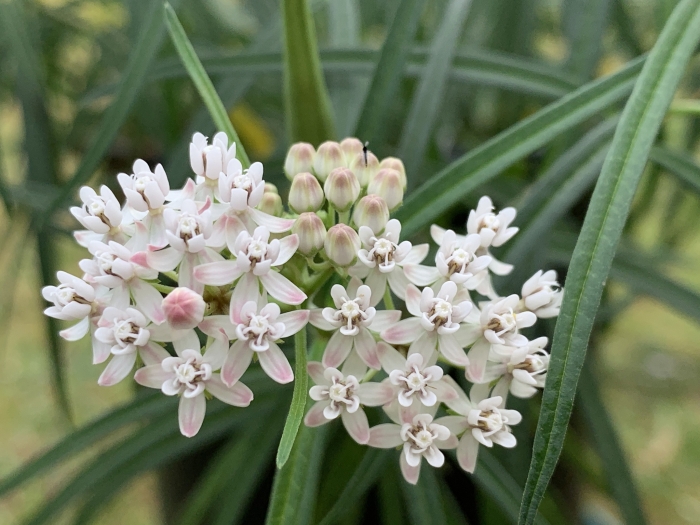Arizona Milkweed
(Asclepias angustifolia)
Arizona Milkweed (Asclepias angustifolia)
/
/

© Brad Grimm
CC BY 4.0
Image By:
© Brad Grimm
Recorded By:
Copyright:
CC BY 4.0
Copyright Notice:
Photo by: © Brad Grimm | License Type: CC BY 4.0 | License URL: http://creativecommons.org/licenses/by/4.0/ | Uploader: growmilkweedplants | Publisher: iNaturalist |

























Estimated Native Range
Summary
Asclepias angustifolia, commonly known as Arizona Milkweed, is a perennial herb native to semi-arid grasslands, riparian woodlands, and canyon edges in Arizona and Mexico. It is typically found at elevations of 3445 to 6890 feet. This species reaches a height of 24-35 inches and features narrow, linear leaves. The flowers are whitish to pink and bloom from late spring to early fall, providing a modest yet attractive display. The plant’s seed pods may also be of interest in the garden for their unique shape and texture.
Arizona Milkweed is crucial for the lifecycle of the Monarch butterfly, serving as a host plant for its larvae. It is valued in cultivation for its drought tolerance and its role in pollinator conservation. It is suitable for xeriscaping, naturalized areas, and wildlife gardens. This milkweed prefers dry, rocky soils and can adapt to various substrates, making it relatively easy to maintain. It requires full sun to part shade and minimal supplemental water once established. While it is commercially available, it remains a rare species in the wild. Gardeners should be aware that milkweeds can be toxic if ingested and may spread if conditions are favorable.CC BY-SA 4.0
Arizona Milkweed is crucial for the lifecycle of the Monarch butterfly, serving as a host plant for its larvae. It is valued in cultivation for its drought tolerance and its role in pollinator conservation. It is suitable for xeriscaping, naturalized areas, and wildlife gardens. This milkweed prefers dry, rocky soils and can adapt to various substrates, making it relatively easy to maintain. It requires full sun to part shade and minimal supplemental water once established. While it is commercially available, it remains a rare species in the wild. Gardeners should be aware that milkweeds can be toxic if ingested and may spread if conditions are favorable.CC BY-SA 4.0
Plant Description
- Plant Type: Herb
- Height: 2.5-3.3 feet
- Width: 1.6-2.5 feet
- Growth Rate: Moderate
- Flower Color: Pink, White
- Flowering Season: Spring, Summer
- Leaf Retention: Deciduous
Growth Requirements
- Sun: Full Sun, Part Shade
- Water: Low
- Drainage: Fast
Common Uses
Bee Garden, Butterfly Garden, Drought Tolerant, Low Maintenance
Natural Habitat
native to semi-arid grasslands, riparian woodlands, and canyon edges in Arizona and Mexico
Other Names
Common Names: Narrowleaf Milkweed, Inmortal, Narrow-Leaved Milkweed, Sonoran Milkweed
Scientific Names: , Asclepias angustifolia, Asclepias angustifolia, Asclepias jaliscana, Asclepias linifolia, Asclepias linifolia, Asclepias rubricaulis, Asclepias salicifolia, Asclepias tapalpana, Asclepias virgata
GBIF Accepted Name: